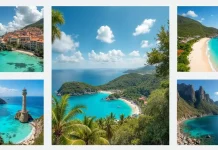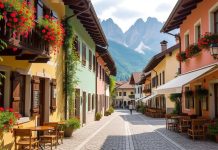Discovering American Samoa: A Hidden Gem in the Pacific
Geographical Overview
Location and Climate
American Samoa, an unincorporated territory of the United States, lies in the heart of the South Pacific. Situated southeast of Samoa, it consists primarily of five volcanic islands and two coral atolls. The main island, Tutuila, hosts the territory’s capital, Pago Pago, and serves as the hub for travel and commerce. The tropical climate is typically warm and humid year-round, with an average temperature ranging from 72°F to 86°F. It’s essential to plan your visit around the two main seasons: the dry season (May to October) and the wet season (November to April).
Natural Beauty and Wildlife
American Samoa boasts stunning landscapes, from lush rainforests to pristine beaches and dramatic cliffs. The territory is home to the National Park of American Samoa, which spans three islands with its diverse ecosystems and unique wildlife. You’ll encounter flying foxes, various species of birds, and vibrant marine life. Its untouched nature makes American Samoa an enchanting destination for nature lovers and adventure seekers alike.
Cultural Insights
Fa’a Samoa: The Samoan Way
Central to the experience of American Samoa is its rich cultural heritage, known as Fa’a Samoa, or “The Samoan Way”. This traditional way of life emphasizes community, respect, and harmony with nature. As you interact with locals, you’ll discover that family (aiga) and church (lotu) play vital roles in everyday life. Traditional ceremonies often feature tatau, intricate tattoos that symbolize strength, leadership, and deep-rooted cultural ties.
Language and Traditions
While English is widely spoken, especially in business and government, the primary language in American Samoa is Samoan. When exploring local villages, you’ll observe traditional architecture, with fale (open-sided houses) forming the heart of community interaction. Embrace local events such as fiafia nights, where dance, music, and feast bring Samoan culture to life.
Practical Travel Tips
Getting There and Around
Most travelers arrive in American Samoa by flying into Pago Pago International Airport (PPG), serviced by flights from Honolulu, Hawaii. From there, local buses, known as aiga buses, are a budget-friendly and popular way to get around the main island. Car rentals are also available for those who prefer more flexibility. Inter-island travel typically involves small boats or planes, offering breathtaking views en route.
Accommodation Options
Lodgings range from guest houses and budget-friendly hostels to the more comfortable western-style hotels. While facilities may be basic compared to large metropolitan tourist destinations, the hospitality and warmth of the Samoan people make up for any lack of luxury. It’s advisable to book accommodations in advance, especially during peak travel seasons.
Exploring the Islands
Tutuila Island
As the largest and most developed island, Tutuila offers a multitude of attractions. Spend time exploring Pago Pago Harbor, one of the most picturesque natural harbors in the world. Venture to the sacred site of A’asu village, or hike to the panoramic viewpoints of Mount Alava. Pay a visit to Fagatogo Bay for its lively marketplace and chance to sample Samoa’s local cuisine.
Manu'a Islands
Comprising Ofu, Olosega, and Ta’u, the Manu'a Islands offer a more remote and unspoiled experience. Ofu Island is particularly famed for its beach, considered one of the most beautiful in the region, if not the world. While there, snorkel or dive among vibrant coral reefs teeming with biodiversity.
Swains and Rose Atolls
For those intrepid explorers seeking true isolation, Swains and Rose Atoll offer adventure in pure wilderness. These remote areas are largely undeveloped, providing perfect settings for bird watching, research expeditions, or simple tranquility among the natural world.
Culinary Delights
Local Dishes to Try
Samoan cuisine is a delightful blend of Polynesian and Western influences. While in American Samoa, indulge in traditional dishes like palusami, taro leaves baked with coconut milk, and oka, fresh raw fish marinated in lemon and coconut cream. Street food is a culinary journey, with easily accessible delights such as pani popo (Coconut rolls) and pisupo (corned beef).
Dining Etiquette
Dining in American Samoa often takes place in communal settings, where sharing food is a significant aspect of the social fabric. You may be invited to a family meal, known as a fiafia, featuring an umu (earth oven) to steam local delicacies. It's customary to bring a small gift as a token of gratitude when invited to dine with locals.
Activities and Adventures
Outdoor Pursuits
From hiking through the rainforests of the National Park of American Samoa to kayaking along crystal-clear waters, outdoor enthusiasts will find no shortage of activities. Diving and snorkeling are particularly rewarding, with a chance to see colorful coral gardens and an array of ocean life. For thrill seekers, explore ava (fiery pits) via challenging hikes or rock climbs.
Cultural Experiences
Engage with the local culture through village tours that offer a window into traditional Samoan life. Participate in a local pastime like the fa'a tele (canoe racing) or weave through small art galleries and handicraft shops that display the talent and craftsmanship of Samoan artisans. Music and dance, central to Samoan life, are celebrated in various festivals and events that occur throughout the year.
Safety and Health Considerations
Health Precautions
While American Samoa is generally a safe destination, it’s wise to take standard health precautions. Ensure your routine vaccinations are up to date and consider additional vaccinations for Hepatitis A and Typhoid, especially if you plan to explore rural areas. The healthcare system is basic, and travelers with specific health concerns should bring sufficient medical supplies.
Respecting Local Customs and Guidelines
Respect for local culture is paramount. When visiting villages, adhere to custom dress codes which favor modesty. Refrain from taking photographs of locals or their homes without permission. Always remove shoes before entering a fale, as a sign of respect toward the hosts.
Planning Your Budget
Cost of Living
Travelers often find American Samoa to be relatively affordable. Local food, transport, and lodgings won’t significantly strain budgets, yet it’s important to account for the additional cost of travel and import goods. Souvenirs and handcrafts offer great value for those looking to bring a piece of Samoa home.
Money Matters
The local currency is the U.S. Dollar, and prices align closely with those in mainland United States. Credit cards are accepted in major establishments, though it’s advisable to carry cash for smaller vendors and rural locations. ATMs are available but can be limited outside major towns.
Environmental Responsibility
Preservation Efforts
Preservation of American Samoa’s natural resources is a priority for both the government and its people. Visitors are encouraged to practice responsible tourism, support local businesses, and minimize their environmental footprint. Adhere to park regulations and guidelines to help maintain the pristine beauty of the islands.
Involvement Opportunities
For environmentally conscious travelers, volunteer opportunities abound in conservation projects. Whether it’s participating in beach cleanups or supporting sustainable tourism initiatives, contributing to the ecological welfare of American Samoa is a rewarding endeavor.
Final Thoughts on Your Journey
American Samoa’s captivating landscapes, rich cultural tapestry, and unrivaled hospitality create an unparalleled travel experience. Whether seeking adventure, tranquility, or cultural immersion, American Samoa offers an authentic and enriching journey through the heart of Polynesia. Remember, respect for local culture and mindful travel practices will enhance your visit, ensuring that the magic of this Pacific paradise endures for future generations to enjoy.































